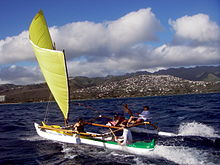Canoeing
Canoeing is a variant of sailing that emerged from canoeing . Canoe sailboats are among the fastest single-handed sailboats in the world.
design type
Sailing canoes, in contrast to dinghies one instead transom stern a pointed tail. There is the national class " Taifun " and the international class "IC" (International Canoe). "IC 10" stands for a sail area of 10 square meters. The boats are sailed one-handed in the adult area, but typhoons in the youth area are also sailed with multiple hands, are 5.20 m long and have a mainsail and a foresail and in some areas require a driver's license .
history
The British crown attorney and founder of the sea scouts , Warington Baden-Powell (1847–1921) played a key role in the development of the sailing canoe . In 1871, at the age of 24, he paddled and sailed in a canoe on the Baltic Sea with stops in Germany , Denmark and Sweden . He wrote down his experience in his book Canoe Traveling , published in 1871.
The first regattas were held in England in 1882 . German championships have been held since 1931, European championships have been held since 1936 and world championships since 1961. These take place every three years.
organization
Canoeing is internationally united in the International Canoe Federation (ICF).
In Germany, canoeing is organized in both the German Canoe Association (DKV) and the German Sailing Association (DSV). The canoe sailing department in DKV was established on November 17, 1973, and on December 17, 1974 the DSV recognized the class associations of the boat classes "IC" (code no. 510) and "Taifun" (code no. 511).
